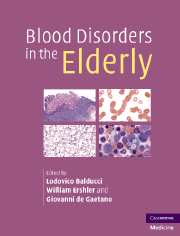Book contents
- Frontmatter
- Contents
- List of contributors
- Preface
- Part I Epidemiology
- Part II Hematopoiesis
- 5 Stem cell exhaustion and aging
- 6 Hematopoietic microenvironment and age
- 7 Replicative senescence, aging, and cancer
- 8 Qualitative changes of hematopoiesis
- 9 Aging and hematopoietic stress
- 10 Immunoglobulin response and aging
- 11 Biological and clinical significance of monoclonal gammopathy
- Part III Anemia of aging
- Part IV Hematologic malignancies and aging
- Part V Disorders of hemostasis in the elderly
- Index
11 - Biological and clinical significance of monoclonal gammopathy
from Part II - Hematopoiesis
Published online by Cambridge University Press: 21 October 2009
- Frontmatter
- Contents
- List of contributors
- Preface
- Part I Epidemiology
- Part II Hematopoiesis
- 5 Stem cell exhaustion and aging
- 6 Hematopoietic microenvironment and age
- 7 Replicative senescence, aging, and cancer
- 8 Qualitative changes of hematopoiesis
- 9 Aging and hematopoietic stress
- 10 Immunoglobulin response and aging
- 11 Biological and clinical significance of monoclonal gammopathy
- Part III Anemia of aging
- Part IV Hematologic malignancies and aging
- Part V Disorders of hemostasis in the elderly
- Index
Summary
Introduction
Monoclonal gammopathy of unknown significance (MGUS) affects up to 2% of persons aged 50 years or over, and about 3% of those older than 70 years. The aim of this chapter is to highlight some of the features of this disease process and its relationship to aging. It will focus on (1) epidemiology, (2) biology of MGUS and the role of various cytokines in the pathophysiology, (3) correlation of the biology of MGUS with aging, (4) diagnosis and follow-up of patients with MGUS, and (5) natural history and predictors of progression in patients with MGUS.
Epidemiology
The monoclonal gammopathies are a group of disorders associated with proliferation of a single clone (monoclonal) of plasma cells. They are characterized by the secretion of an immunologically homogenous monoclonal protein (M-protein, M-component, M-spike, or paraprotein). Each M-protein consists of two heavy (H) polypeptide chains of the same class and subclass, and two light (L) chains of the same type. The heavy chains are IgG, IgM, IgA, IgD, and IgE, while the light-chain types are kappa (κ), and lambda (λ). In contrast, a polyclonal gammopathy is characterized by an increase in one or more heavy chains, and in both types of light chains, and is usually associated with an inflammatory or reactive process.
- Type
- Chapter
- Information
- Blood Disorders in the Elderly , pp. 138 - 154Publisher: Cambridge University PressPrint publication year: 2007



